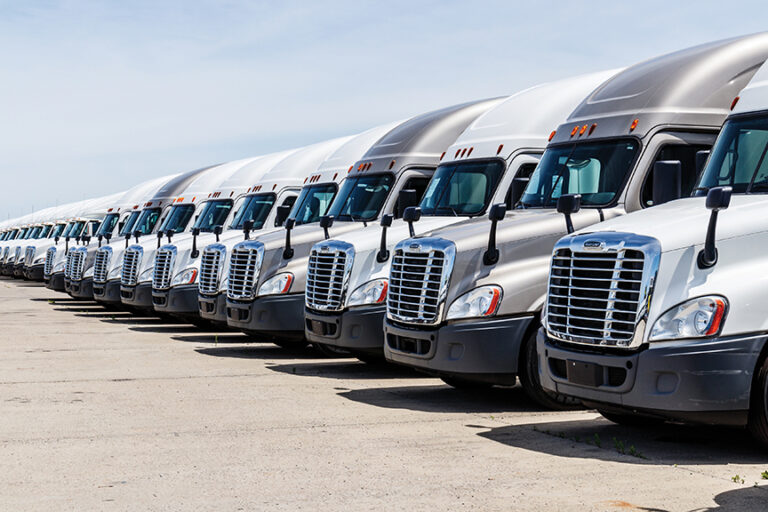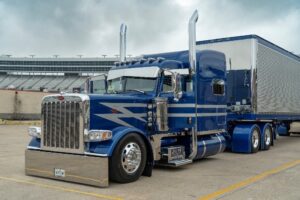The North American market for new Class 8 trucks continued to climb in September in response to record freight rates and solid shipment numbers. According to data received from ACT Research, 19,380 trucks were sold in September, outdistancing the 17,977 sold in August by 7.8%.
Compared to September 2019, when 28,624 new trucks were sold, sales declined by 32.3%. However, considering that last September was the best September ever for new truck sales, the decline doesn’t look so bad. A better perspective might be that of the past 20 years, seven Septembers have been better and 12 have been worse.
Of the trucks sold in September, 14,404 (74.3% of the total) were over-the-road tractors, while 4,976 (25.7%) were vocational trucks such as dump, trash or concrete. Last year, 73.1% of new Class 8 trucks were OTR models, but that percentage was lower than 70% for the first seven months of 2020, dropping as low as 54.6% in May.
In ACT’s October upgrade to its North American Commercial Vehicle Outlook, Kenny Vieth, ACT’s president and senior analyst, explained that the current freight market is different than markets in the past.
“We’re seeing a COVID-driven consumer and business substitution of spending from services to goods, and while a vacation or business trip doesn’t fit into a truck, lumber and technology do,” he said, noting that businesses will be rebuilding inventories that were depleted during COVID-19 shutdowns, resulting in a rebound of manufacturing.
“By Q1 2021, the current manufacturing cycle will hit a nine-quarter downturn, suggesting a tightly coiled spring of pent-up demand, also good for freight and ultimately commercial vehicle demand,” he said.
As sales of new trucks were rising, so were orders for future deliveries of new trucks. ACT reported 30,700 new orders for Class 8 equipment in September, up 37% from August orders — and an incredible 145% higher than September 2019 orders. Last fall, buyers were accepting large numbers of trucks they had previously ordered while slowing up on new orders in preparation for a difficult 2020.
Despite shutting down production shifts and reducing workforces, manufacturers made progress on decreasing the backlog of ordered trucks
“As orders rebounded to relatively healthy levels early in Q3, most of those orders were targeted at filling open 2020 build slots,” Vieth said. “With most of that work done by the end of August, we suspect the lion’s share of September’s orders were booked into 2021.”
Sales of used trucks rose in September, too, according to ACT’s State of the Industry: U.S. Classes 3-8 used trucks report. Sales volumes at dealers rose 17% year to date compared to the first eight months of the year. While volumes were up, average miles and age both fell slightly, and average prices were still below last year’s pace.
Of the new Class 8 trucks sold in September, 40.3% of them were Freightliners. The company moved 7,713 of them — 447 more than the 7,266 sold in August — according to data received from Wards Intelligence (wardsintelligence.com). For the year to date, Freightliner leads all OEMs with sales of 49,663 but still trails last year’s 78,591 in the first nine months by 36.8%.
Kenworth’s 2,800 sold was second-best in the industry, besting the 2,385 sold in August by 17.4%. Compared to September 2019, sales declined 26.9%, the smallest decline of any of the OEMs. Peterbilt saw a 10.6% increase over August sales with 2,686 sold in September compared to 2,428 the prior month. Compared with September 2019, when 3,718 were sold, sales declined 27.8%
Mack sold 1,319 trucks in September, an increase of 298 units representing 29.2% compared to August. It was the largest month-over-month gain on a percentage basis of all the manufacturers. Compared to September 2019, however, Mack sales dropped by 32.8%, also the largest drop of the manufacturers.
Volvo fared better with sales of 1,960 trucks, 89 more than in August for a gain of 4.8%. Compared to September 2019, Volvo sold nine more trucks for a gain of 0.5%, the only year-over-year gain of any OEM.
Western Star’s 391 trucks sold in September was 9.9% less than August and 45.5% lower than September 2019 sales, when the company moved 717 trucks. For the year to date, sales were 19.8% behind last year’s pace, the lowest decline of any OEM.
Hino got on the scoreboard with sales of one truck in September, but the manufacturer sold twice that many in September 2019, so on paper it looks like a sales decline of 50%. The company’s XL model will be offered in both extended-cab and crew cab configurations in 2021 but still won’t have a sleeper option. Hino is known for medium-duty trucks used in local operations, and entered the Class 8 market last year.
International lost ground compared to August, but not by much. The company sold 2,256 trucks in September, just 23 fewer than in August for a 1% decline. Compared with September 2019, sales dropped by 1,334 trucks for a 37.2% decline.
On Oct. 16, TRATON SE, the commercial truck unit of Volkswagen AG, agreed in principle to purchase remaining Navistar shares for approximately $3.7 billion. TRATON, which also owns the European MAN, Scania and Brazil’s Volkswagen Caminhoes e Onibus (Volkswagen Truck and Bus), already owned 16.8% of Navistar stock.
Volkswagen has long sought an entry into the North American Class 8 market, and the Navistar acquisition provides the dealer and service network — and manufacturing facilities — to make it happen. While it may be months before the deal is finalized, it remains to be seen how the announced acquisition will impact International truck sales for the remainder of the year. For the longer term, there almost certainly will be some integration of parts and technologies from other TRATON subsidiaries, provided the deal is finalized.
Several factors could still influence sales of new trucks for the remainder of the year. Not the least is the national election, taking place just two days after this issue of The Trucker hits newsstands. Another government stimulus may or may not occur, and spikes in COVID-19 cases could cause further shutdowns or restrictions on businesses. For now, it’s looking like a big fourth quarter of 2020 for the new truck market followed by a solid start to 2021.
Cliff Abbott is an experienced commercial vehicle driver and owner-operator who still holds a CDL in his home state of Alabama. In nearly 40 years in trucking, he’s been an instructor and trainer and has managed safety and recruiting operations for several carriers. Having never lost his love of the road, Cliff has written a book and hundreds of songs and has been writing for The Trucker for more than a decade.








